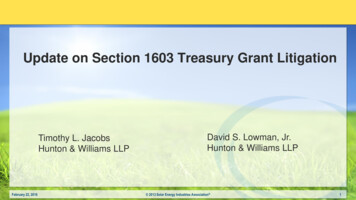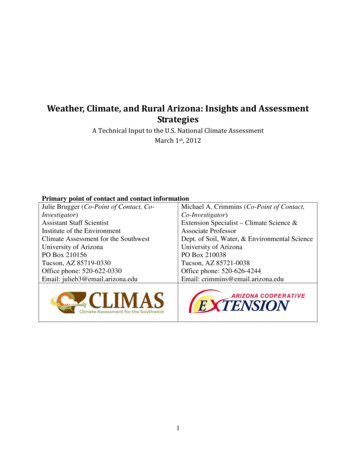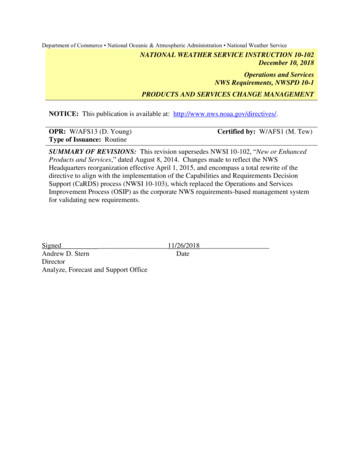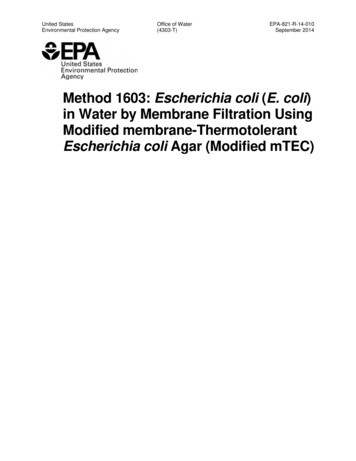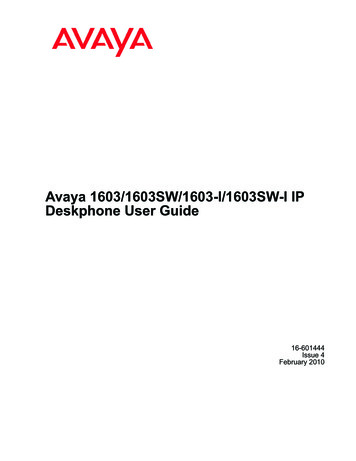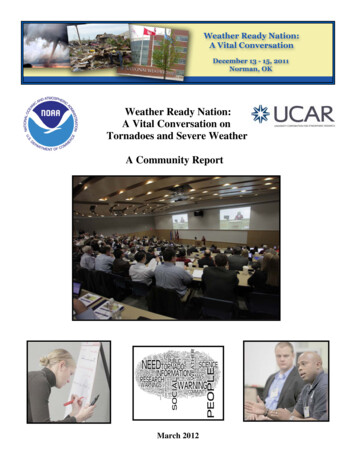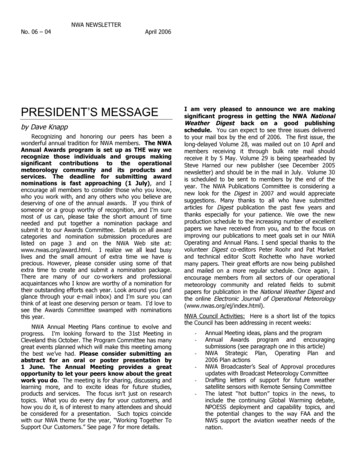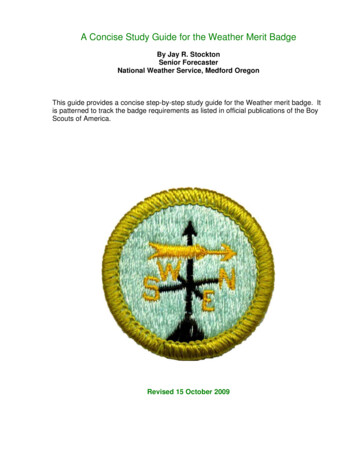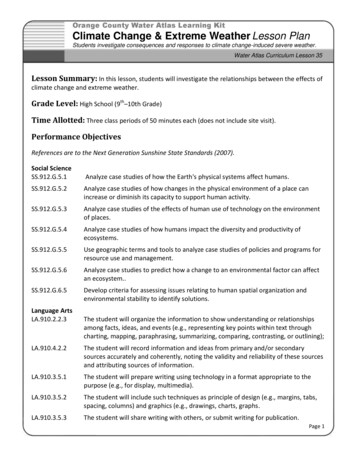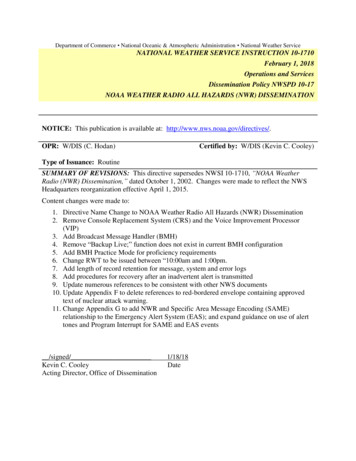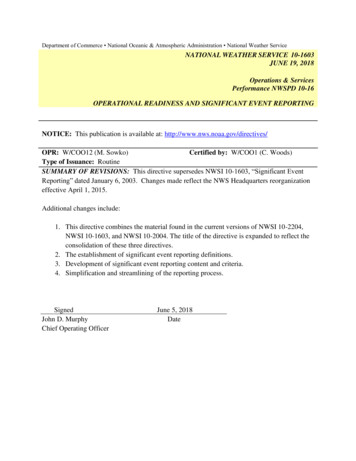
Transcription
Department of Commerce National Oceanic & Atmospheric Administration National Weather ServiceNATIONAL WEATHER SERVICE 10-1603JUNE 19, 2018Operations & ServicesPerformance NWSPD 10-16OPERATIONAL READINESS AND SIGNIFICANT EVENT REPORTINGNOTICE: This publication is available at: http://www.nws.noaa.gov/directives/OPR: W/COO12 (M. Sowko)Certified by: W/COO1 (C. Woods)Type of Issuance: RoutineSUMMARY OF REVISIONS: This directive supersedes NWSI 10-1603, “Significant EventReporting” dated January 6, 2003. Changes made reflect the NWS Headquarters reorganizationeffective April 1, 2015.Additional changes include:1. This directive combines the material found in the current versions of NWSI 10-2204,NWSI 10-1603, and NWSI 10-2004. The title of the directive is expanded to reflect theconsolidation of these three directives.2. The establishment of significant event reporting definitions.3. Development of significant event reporting content and criteria.4. Simplification and streamlining of the reporting process.SignedJohn D. MurphyChief Operating OfficerJune 5, 2018Date
NWSI 10-1603 June 19, 2018Operational and Significant Event ReportingTable of Contents1.Introduction . 12.Significant Event Definitions . 12.12.2Significant Damage:. 1Major Impacts To Public Infrastructure:. 23.Reportable Events . 24.Outlooks for Significant Events . 25.Additional NWSOC Reportable Events. 26.Reporting Process . 37.Report Content . 38.Protection of Records . 41. IntroductionThe NWS Operations Center (NWSOC), NWS Regional Offices and/or formalized RegionalOperations Centers (ROCs), National Centers and other operational units throughout the agencymeet the evolving needs of NWS partners and stakeholders and support agency readiness byproactively collaborating and facilitating the exchange of critical information. Effectivemessaging begins with the establishment of consistent reporting criteria and messagingprocesses, particularly between the regional offices and the NWSOC.2. Significant Event Definitions2.1 Significant Damage:At least one of the following due to a hydro-meteorological event: Significant damage to a well-known structure Significant damage to numerous homes or other substantial buildings Natural damage on a large scale (e.g., several square miles of a forest flattened, orthousands of acres of crops destroyed)1
NWSI 10-1603 June 19, 20182.2 Major Impacts to Public Infrastructure:At least one of the following due to a hydro-meteorological event: Telecommunications or power outages affecting a significant portion of a population Closure of a major highway or a vital thoroughfare Major airport closure Evacuation or closure of numerous offices, stores, and/or government facilities Community evacuated3. Reportable EventsField offices will notify their ROC using any process acceptable to the ROC. The ROC willprovide a report of that information to the NWSOC. Reports are required when any one (ormore) of the following occurs as a result of a hydro-meteorological event: One or more deaths that are directly related to the event Five or more injuries that are directly related to the event Significant damage or major impacts to public infrastructure (definition above)Additionally, National Centers for Environmental Prediction (NCEP) centers should send areport to the NWSOC as early as possible following a high impact event that is related to thecenter’s area of forecast expertise. The report will summarize the event, its impacts, and theforecast services and/or Impact-based Decision Support Services (IDSS) provided by the center.*See table “Reporting Criteria” for specific, reportable hazards and events.4. Outlooks for Significant EventsROCs will send a report to the NWSOC when a hydro-meteorological event is forecast thatcould result in significant damage or major impacts to public infrastructure as previouslydefined. Similarly, an NCEP center, corresponding to its area of expertise, should send a reportto the NWSOC and to the affected ROC when the center determines with reasonable certaintythat a significant event (as defined above) will occur.5. Additional NWSOC Reportable EventsOther events NWSOC will report to NOAA and NWS Senior Leadership include, but are notlimited to, the following: Predicted or observed solar events S3/G3 or above Any measurable tsunami2
NWSI 10-1603 June 19, 2018 Tropical cyclone formation/upgrade Damage to NWS facilitieso NWSOC will obtain through the appropriate ROC to report the following: Impacts to NWS staff Cause and extent of damage; percent of building remaining habitable Estimated date and time when facility will be available for occupancy Amount and type of equipment damaged and repairable, damaged beyond economicalrepair, or lost/destroyed.6. Reporting ProcessWhen conditions as defined previously are met, a ROC and/or National Center will prepare aRegional Significant Event Report or Significant Event Outlook, or its equivalent, for submissionto the NWSOC.Reports will be sent via email to: nws.opscenter@noaa.gov with a cc: to any appropriate party atthe local or regional level as determined by the sender. NWSOC will either forward the report orwill use the input as source material to produce deliverables used to inform numerous internaland external stakeholders. NWSOC stakeholders include, but are not limited to, NOAA/NWSexecutives, NWS portfolio directors, and other recipients appropriate to the incident type. Theserecipients can include: NOAA FEMA liaisonNWS FEMA Incident Management Assistance Team (IMAT) meteorologistsFire weather program leads and managers (for wildfire related incidents)SPC management (for severe and fire weather incidents)NWS Forensics Services Program Lead (for all accident-related incidents)WPC management for hydrologic related incidentsNational Water Center for riverine floodingAWC and NAMs for aviation-related incidents or for forecast events that could impactdomestic airspace Other offices and entities deemed appropriate for an event by NWSOC7. Report ContentThe following will be included in a Significant Event Report/Outlook: Event name and location(s) affected Reporting office’s contact information3
NWSI 10-1603 June 19, 2018 Date and time of the report (local time)Date and time of the incident (local time)Event description, including applicable items listed in “Reportable Events”IDSS provision to core and deep relationship core partners:o Support to member of the emergency management community, government partners whorequire close coordination with NWS, or members of the electronic media Key activities undertaken or known decisions by core and deep relationship core partners inresponse to NWS IDSS Performance metrics NWS systems preparedness activities and/or known issues with NWS systems that mayaffect NWS performance of mission related to the event8. Protection of RecordsFor reporting of incidents that involve aircraft accidents, major marine incidents, or a surfacebased transportation incident, a NWS office will follow the guidance in NWSI 10-2003 (RecordsRetention) to determine what records need to be secured for potential investigation or litigationpurposes.4
NWSI 10-1603 June 19, 2018Reporting CriteriaIncidentReporting Criteria (if any)Tornado / Severe WeatherHydrologic Events: Flooding / Flash FloodingDam/Levee Failure / Ice JamsStrong Winds (non- thunderstorm)Tropical Events 1 or more fatalitiesWinter Weather 5 or more serious injuriesRip Currents, High Surf, Coastal Flooding Significant damage, or major impactsto public infrastructure as defined by10-1603Extreme Heat, Extreme Cold, Wind ChillLightningWildfireTsunamiWeather-related surface-based transportationincident (rail, subway, highway, etc.)Report if: Weather-related, and any of thefollowing: 1 or more fatalities 5 or more serious injuries Involve notable public figure(s)Aircraft Accident(involving airline/air taxi/air charter)Major Marine IncidentNWS Forensics Program requirements: For aircraft accidents: The local WFOwill contact AOMC and request ASOSarchive (regardless if weather issuspected to be the cause) if the ASOS5
NWSI 10-1603 June 19, 2018is within 25NM of the incident. For marine accidents: The local WFOwill download the data for the last 12hours from the closest marineobservation to the accident. The windand wave data may be obtained frombuoys, C-Mans, and/or any platformavailable at the time of the accident.These data should be retained at the issuingoffice for at least 30 days, except wheninstructed otherwise by the Forensic ServicesProgram Lead.Report airport closures that meet thefollowing Weather-related Closed via Notice to Airmen(NOTAM) Reported to the FAA ATCSCC Have impact on the National AirspaceAirport Closure (weather-related)Aviation Weather Center NAMs will monitorand report these closures IAW Para. 5. DuringNAM non-working hours, the AWC Lead willreport airport closures as their shift dutiesallow.Volcanic Activity Any volcanic eruption Impactful volcanic ashfall asdetermined by the reporting ROC Lahars (volcanic induced debris flows)Hazardous Materials Incident Issuance of a Civil EmergencyMessage Support to Interagency Modeling andAtmospheric Assessment Center(IMAAC) Any request for HYSPLIT support6
NWSI 10-1603 June 19, 2018 Significant engagement with, orservices provided to, core partners orstakeholders e.g. OR&R, EPA, USCG,etc.Direct Request for Onsite Decision SupportServices to government officialsUse NWSOC Deployment trackingmechanism(Any onsite IDSS provided (whetherscheduled or event-driven) consisting of afull shift OR to a particularly noteworthypartner and/or all SEAR 1 events)Direct Request for NWS participation inincident investigation (NTSB, US CoastGuard)Forensics Service Manager will report anyrequest for NWS staff involvement orinterviewsNWS Personnel Incident, Injury, WorkRelated Illness(See NOAA Handbook 209-40)Hyperlink to NOAA Handbook reporting Any damage or outage that degrades aNWS facility’s ability to provide missionessential functions lasting at least 6hours, or shorter if the incident willdegrade WWAs or receive negativefeedback from core partners or the public. Any Continuity of Operations Planactivation Inadvertent Product Release resulting inEAS activation or that results in negativemedia.Extended Equipment or SystemsDegradation/Outage at an NWS facility ORMission-related interruption/incidentNote: Information flow (NWSOC ROCs) Activation of a Quick Response TeamStorm Survey Major damage to an NWS facility.NWS Facility Incident Any civil disturbance impacting NWSemployees or facilities7
NWS FEMA Incident Management Assistance Team (IMAT) meteorologists . incident investigation (NTSB, US Coast Guard) Forensics Service Manager will report any request for NWS staff involvement or interviews NWS Personnel Incident, Injury, Work Related Illness (See NOAA Handbook 209-40) Hyperlink to NOAA Handbook reporting Extended Equipment or .
